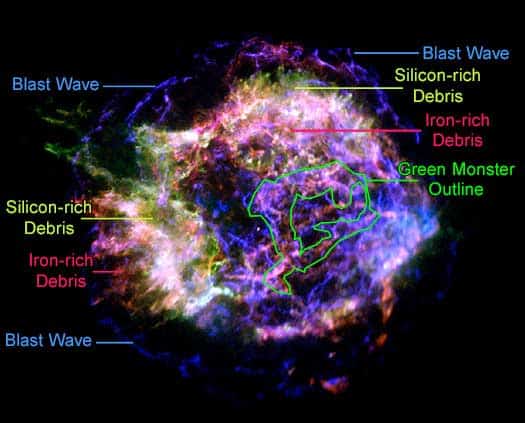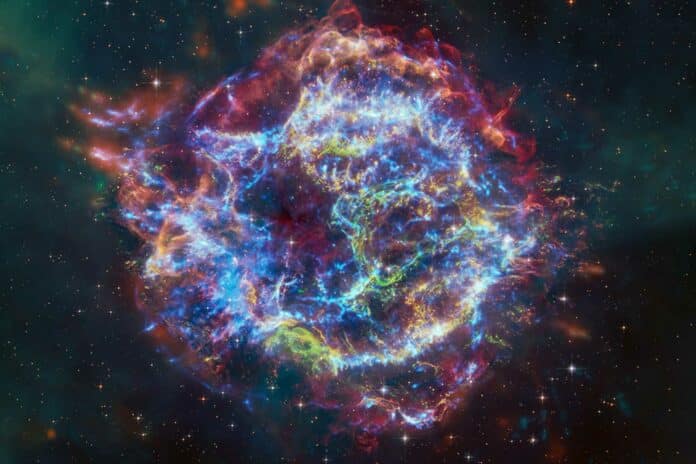Astronomers have, for the first time, combined data from NASA’s Chandra X-ray Observatory and the James Webb Space Telescope to study the well-known supernova remnant Cassiopeia A (Cas A). This collaborative effort has shed light on an unusual structure in the debris known as the “Green Monster,” first discovered in Webb data in April 2023. The research has also revealed new insights into the explosion that created Cas A approximately 340 years ago, from Earth’s perspective.
The composite image includes X-rays from Chandra (blue), infrared data from Webb (red, green, blue), and optical data from Hubble (red and white). The outer parts of the image also feature infrared data from NASA’s Spitzer Space Telescope (red, green, and blue). The outline of the Green Monster is highlighted in the image.
The Chandra data provides insights into the hot gas, primarily from supernova debris of the destroyed star, containing elements such as silicon and iron. In the outer regions of Cas A, the expanding blast wave interacts with surrounding gas ejected by the lead before the explosion. Energetic electrons spiraling around magnetic field lines in the blast wave produce the X-rays. These electrons create thin arcs of light in the outer regions and some parts of the interior of Cas A.
Webb’s infrared data highlights emission from dust, warmed up as it is embedded in the hot gas observed by Chandra, and from much cooler supernova debris. The Hubble data showcases stars in the field.

A separate graphic of the Chandra image uses color to represent different X-ray energies:
- Red indicates iron and magnesium at low X-ray energies.
- Green indicates silicon at intermediate X-ray energies.
- Blue represents the highest energy X-rays from electrons spiraling around magnetic field lines.
The outline of the Green Monster, along with the locations of the blast wave and debris rich in silicon and iron, is labeled.
When scientists carefully analyzed the data, they found that the filaments in the outer part of Cas A from the blast wave are closely similar to the X-ray properties of the Green Monster, including less iron and silicon than in the supernova debris.
The interpretation is evident in the color Chandra image, where the colors within the outline of the Green Monster closely match the colors of the blast wave rather than the debris rich in iron and silicon. This leads the researchers to conclude that the Green Monster was formed by a blast wave from the exploded star colliding with surrounding material, supporting earlier suggestions from Webb data alone.
Chandra observes the debris from the explosion because it is heated to tens of millions of degrees by shock waves, similar to sonic booms from a supersonic plane. On the other hand, Webb can observe some material that has not been affected by shock waves, referred to as “pristine” debris.
To delve deeper into the supernova explosion’s details, the team compared the Webb view of pristine debris and X-ray maps of radioactive elements formed during the supernova. They utilized data from NASA’s Nuclear Spectroscopic Telescope Array (NuSTAR) to map radioactive titanium, still observable today, and Chandra to map the locations of radioactive nickel by measuring the distribution of iron.
Radioactive nickel undergoes decay to form iron. An additional image illustrates the iron-rich debris (tracing the location of radioactive nickel) in green, the radioactive titanium in blue, and the pristine debris observed in orange and yellow.
The Webb observations reveal filaments of pristine debris near the center of Cas A, and these are found to be connected to the iron observed with Chandra farther out. In regions with relatively weak pristine debris, there is an observable presence of radioactive titanium.
These comparisons imply that the radioactive material observed in X-rays has played a role in shaping the pristine debris near the remnant’s center, forming cavities. The intricate structures within the pristine debris likely originated when the inner layers of the star were violently mixed with hot, radioactive matter produced during the collapse of the star’s core under gravity.
Journal References:
- Dan Milisavljevic, Tea Temim, Ilse De Looze et al. A JWST Survey of the Supernova Remnant Cassiopeia A. Astrophysical Journal Letters. DOI: 10.48550/arXiv.2401.02477
- Jacco Vink, Manan Agarwal, Patrick Slane et al. X-ray diagnostics of Cassiopeia A’s “Green Monster”: evidence for dense shocked circumstellar plasma. Astrophysical Journal Letters. DOI: 10.48550/arXiv.2401.02491
